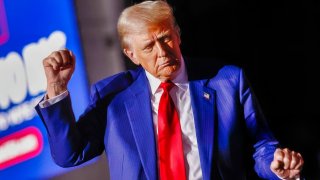Will Donald Trump Restart America's Inflation Crisis?
There is good news and bad news on the inflation front. The good news is that inflation has come down from its May 2022 high of 9 percent to close to the Federal Reserve’s 2 percent inflation target. The bad news is that, if implemented, President-elect Donald Trump’s economic plan will lead to the return of inflation.
There is good news and bad news on the inflation front. The good news is that inflation has come down from its May 2022 high of 9 percent to close to the Federal Reserve’s 2 percent inflation target. The bad news is that, if implemented, President-elect Donald Trump’s economic plan will lead to the return of inflation. The markets have noticed this. Ten-year Treasury bond yields have risen sharply, a strong bid for gold, and a rise in inflation expectations.
Among the main reasons for concern that inflation will return next year is the slew of tax cut promises Mr. Trump made during the election campaign. Not only did he commit to extending the 2017 Tax Cut and Jobs Act, but he also committed to reducing the corporate tax rate from 21 percent to 15 percent and eliminating taxes on social security benefits and tips.
These measures must be expected to cause the budget deficit to swell from its already high level of over 6 percent of GDP and put the public debt on an unsustainable path. According to the Committee for a Responsible Budget, over the next decade, the Trump economic tax cuts could add around $7.75 trillion to the national debt. That could take the public debt-to-GDP ratio to a record high of more than 140 percent.
One way that the tax cuts could add to inflation is by increasing aggregate demand. Other ways that it could do so is by precipitating a dollar crisis and by leading to a spike in mortgage rates as investors flee the dollar and demand higher interest rates to compensate them for inflation risk.
Inflation could also be fueled by a rise in import prices due to Mr. Trump’s aggressive import tariff program. On the campaign trail, he committed to a 60 percent tariff on all Chinese imports and a 10–20 percent tariff on imports from the rest of our trade partners. According to the Peterson Institute for International Economics, these tariffs could raise the price of imported goods and cost the average household around $2600.
A further reason for inflation concern is that Mr. Trump is proposing to deport around 11 million undocumented immigrants. This must be expected to cause supply pressure and a rise in production costs, especially in the agricultural and building sectors of the economy. According to the U.S. Department of Agriculture, about 40 percent of the agricultural labor force is made up of undocumented immigrants. According to the Center for American Progress, undocumented immigrants represent 23 percent of the construction industry’s labor force.
As if all of this were not sufficient reason for concern, Mr. Trump is voicing his intention to have a seat at the table in the Federal Reserve’s interest rate-setting decisions. This could lead to yet another round of the Federal Reserve holding interest rates too low for too long and allowing the money supply to balloon.
The main reason that Kamala Harris lost her bid for the presidency was the public’s anger at the high inflation that they experienced during the Biden administration. It would seem that Mr. Trump would be inviting a shellacking at the 2026 mid-term elections if he let the inflation genie out of the bottle one more time. Maybe for that reason, we can hope that he will walk back many of his inflationary campaign promises. If not, we should batten down the hatches for inflation's return and a high degree of financial market and economic volatility in 2025.
About the Author: Dr. Desmond Lachman
Desmond Lachman is a Senior Fellow at the American Enterprise Institute and was a deputy director in the International Monetary Fund’s Policy Development and Review Department and the chief emerging-market economic strategist at Salomon Smith Barney.
Image: Creative Commons.


